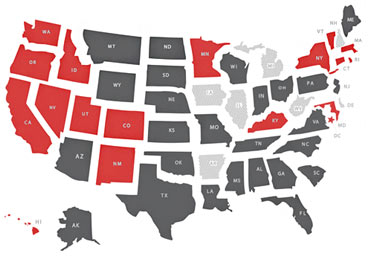Public Exchanges
The Affordable Care Act (ACA) calls for the creation of state-based competitive marketplaces, known as Affordable Health Insurance Exchanges (Exchanges), for individuals to purchase private health insurance. According to the Department of Health and Human Services (HHS), the Exchanges will allow for direct comparisons of private health insurance options based on price, quality and other factors and will coordinate eligibility for premium tax credits and other affordability programs.
ACA requires the Exchanges to become operational in 2014. Enrollment in the Exchanges for eligible individuals and small businesses is expected to begin on Oct. 1, 2013.

Enrollment in Health Insurance Exchanges
Individual Eligibility
An individual will be eligible for enrollment in a “qualified health plan” (QHP) through an Exchange if he or she:- Is a citizen, national or non-citizen lawfully present in the U.S., and is reasonably expected to remain so for the entire period for which enrollment is sought;
- Is not incarcerated; and
- Resides in the state covered by the Exchange.
Each Exchange will determine whether an individual meets the eligibility standards for enrollment. After the Exchange determines eligibility, the Exchange will provide the individual with a timely, written notice of his or her eligibility determination.
Enrollment Periods
The ACA requires Exchanges to have an initial open enrollment period, an annual open enrollment period and certain special enrollment periods. Individuals will only be able to enroll in a QHP through an Exchange during one of the permitted enrollment periods.
Initial Enrollment Period
The initial open enrollment period is expected to run from Oct. 1, 2013, through March 31, 2014. Coverage must be offered effective January 1, 2014, for qualified individuals whose QHP selections are received by the Exchange on or before Dec. 15, 2013. For selections received between the first and 15th day of January, February or March 2014, coverage must be provided effective the first day of the following month. For those received between the 16th day and the last day of any month between December 2013 and March 31, 2014, the Exchange must ensure coverage is effective the first day of the second following month.
Special Enrollment Periods
Qualified individuals and enrollees may be allowed a “special enrollment period” under certain circumstances (such as marriage or birth of a child), during which they could enroll in QHPs or change enrollment from one QHP to another. Each special enrollment period will be 60 days from the date of the triggering event. The effective date of any coverage elected during a special enrollment period follows rules similar to those applicable during initial enrollment. This means that coverage would be effective as of the first day of the month for elections made by the 15th of the preceding month, and on the first day of the second following month for elections made between the 16th and the last day of a given month. However, coverage would be effective on the date of birth, adoption or placement for adoption, when that is the special enrollment triggering event.
Annual Enrollment Periods
The annual enrollment period for 2015 and subsequent years will begin October 15 and extend through December 7 of the preceding calendar year. Starting in 2014, the Exchange must provide advance written notice to each enrollee about annual open enrollment no earlier than September 1, and no later than September 30.
Exchange Functions and Roles
The Exchanges will perform a variety of functions, including:
- Certifying health plans as qualified health plans (QHPs) to be offered in the Exchange;
- Operating a website to facilitate comparisons among QHPs for consumers;
- Operating a toll-free hotline for consumer support, providing grant funding to entities called “Navigators” for consumer assistance and conducting consumer outreach and education;
- Determining eligibility of consumers for enrollment in QHPs and for insurance affordability programs (such as premium tax credits, Medicaid and CHIP state-established basic health plans); and
- Facilitating the enrollment of consumers in QHPs.
- States have flexibility in determining the design of their Exchanges. For example, states may decide whether their Exchanges will be operated by a non-profit organization or a public agency. States may also select the number and type of health plans available in their Exchanges and may determine some of the standards for QHPs, including the definition of required essential health benefits. In addition, states have flexibility to determine a role for agents and brokers, including the use of online brokers, in connection with the Exchanges.
Exchange Health Insurance Subsidies
There are two federal health insurance subsidies available with respect to coverage through an Exchange – premium tax credits and cost-sharing reductions. Both of these subsidies vary in amount based on the taxpayer’s household income and reduce the out-of-pocket costs of health insurance for the insured.
- Premium tax credits are available for people with somewhat higher incomes (up to 400% of FPL), and reduce out-of-pocket premium costs for the taxpayer.
- Reduced cost-sharing is available for individuals with lower incomes (up to 250% of FPL). Through cost-sharing reductions, these individuals will be eligible to enroll in plans with higher actuarial values and have the plan, on average, pay a greater share of covered benefits. This means that coverage for these individuals will have lower out-of-pocket costs at the point of service (for example, lower deductibles and copayments).
For purposes of determining eligibility for these subsidies, and the amount of any subsidy available, household income is determined using the taxpayer’s federal income tax return for that year. However, because these subsidies are provided when the individual purchases insurance, the Exchanges will generally have to determine household income well before the individual files his or her tax return for that year.
To aid the Exchanges in making these determinations, HHS released a draft application for insurance that asks applicants to provide specific information about their current income. If the applicant’s current income is not steady or if they expect it to change, the application asks them to project their 2014 income. If the applicant provides no financial information, the Exchange will rely on the individual’s federal income tax return from the previous year.
At the end of the year, the subsidy amount will be recalculated using the taxpayer’s household income as reported on his or her tax return, and any difference in the amounts will be reconciled. If the taxpayer’s income has increased from the amount that he or she reported to the Exchange, and as a result received a larger subsidy than he or she was entitled to, that individual may have to repay part of their subsidy. This could result in a smaller tax refund or a tax payment due for that individual.
Eligibility for Premium Tax Credits
ACA requires Exchanges to provide information to prospective enrollees about their eligibility for premium tax credits. To be eligible for the premium tax credit, a taxpayer:
- Must have household income for the year between 100 percent and 400 percent of the federal poverty line (FPL) for the taxpayer’s family size;
- May not be claimed as a tax dependent of another taxpayer; and
- Must file a joint return, if married.
- In addition, to receive the premium assistance, a taxpayer must enroll in one or more qualified health plans (QHPs) through an Exchange. The taxpayer cannot be eligible for minimum essential coverage (such as coverage under a government-sponsored program or an eligible employer-sponsored plan).
- Employees who may enroll in an employer-sponsored plan, and individuals who may enroll in the plan because of a relationship with an employee, are generally considered eligible for minimum essential coverage if the plan is affordable and provides minimum value.
- Employees who are eligible for minimum essential coverage (that is affordable and provides minimum value) through an employer-sponsored plan are not eligible for the premium tax credit. This is significant because ACA’s shared responsibility penalty for large employers is triggered when a full-time employee receives a premium tax credit for coverage under an Exchange. An employee who is not eligible for a tax credit may still be eligible to enroll in a QHP through an Exchange. However, this would not result in a shared responsibility penalty for the employer.
Affordability Determination
- To determine an individual’s eligibility for a tax credit, ACA provides that employer-sponsored coverage is not considered affordable if the employee’s cost for self-only coverage exceeds 9.5 percent of the employee’s household income for the tax year.
